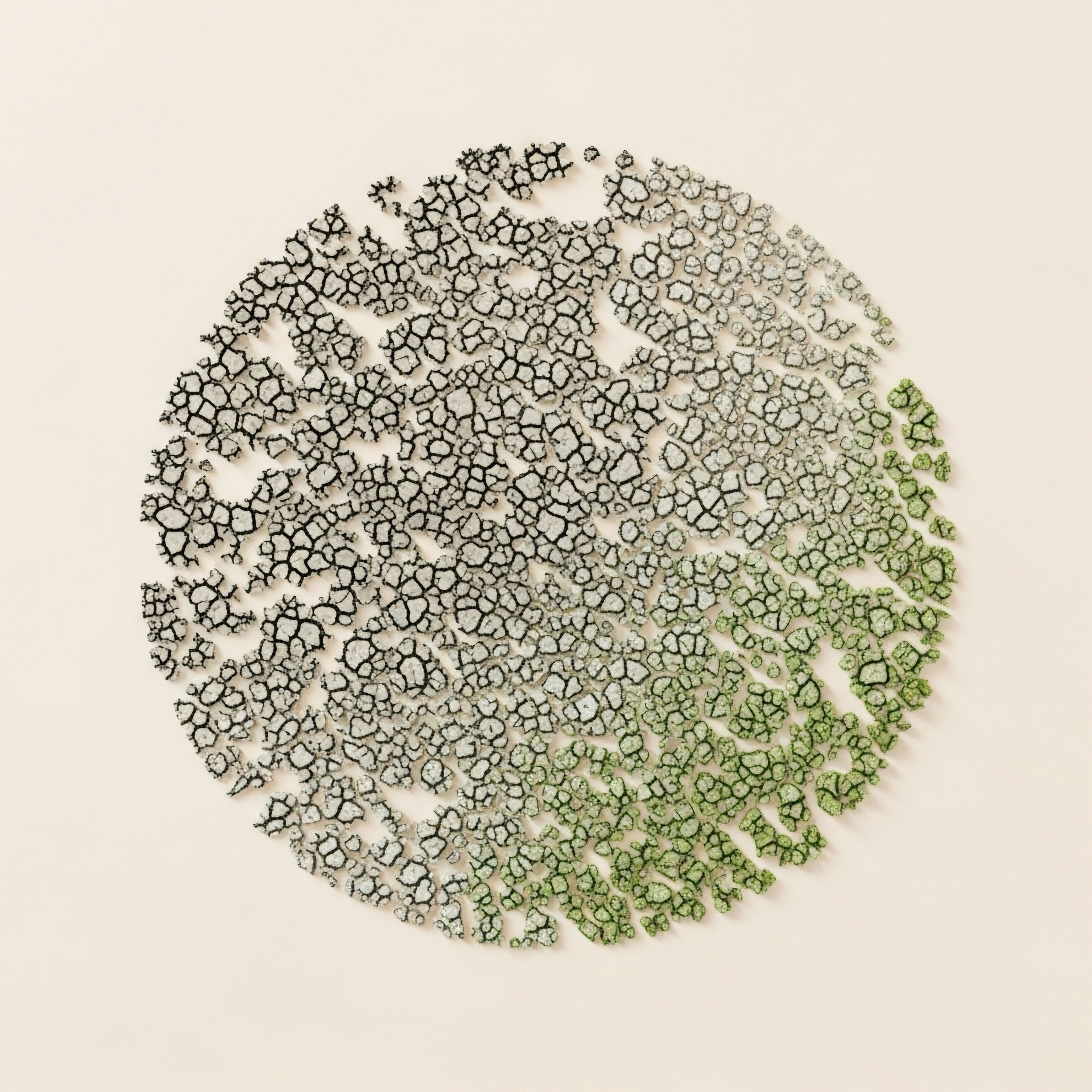

Fundamentals
The conversation about cardiovascular health often begins with a diagnosis, a number on a lab report, or a feeling of diminished capacity that is difficult to articulate. It can manifest as a subtle loss of stamina during activities you once enjoyed, a new awareness of your own heartbeat, or the sobering realization that your body’s resilience is not what it once was.
This experience is a deeply personal one, a narrative written in the language of symptoms and concerns. The path to understanding what is happening within your own circulatory system starts with acknowledging this reality. Your body is communicating a shift in its internal environment, and learning to interpret this language is the first step toward reclaiming your vitality.
At the center of this internal world is the heart, an organ of incredible strength and endurance. It is a highly metabolic muscle, demanding a constant supply of energy and intricate signaling to function optimally. Its health is inextricably linked to the body’s master communication network ∞ the endocrine system.
This system of glands and hormones functions like a complex orchestra, releasing precise chemical messengers that regulate everything from your metabolism and energy levels to your stress response and cellular repair. When this orchestra is in tune, the body operates with a seamless, background hum of efficiency. When a key instrument falls silent, the entire composition is altered.
The gradual decline of specific hormones is a central feature of the aging process, directly impacting the body’s ability to maintain cardiovascular resilience.

The Conductor of Cellular Health
One of the most significant conductors in this endocrine orchestra is Growth Hormone (GH). Produced by the pituitary gland, GH is a primary driver of cellular regeneration, tissue repair, and metabolic balance. During youth, it fuels our growth. In adulthood, it sustains our vitality.
As we age, the pituitary gland’s production of GH naturally wanes in a process known as somatopause. This decline is not a disease in itself; it is a predictable feature of the human lifespan. The consequences of this hormonal shift, however, ripple throughout the body, with particularly significant effects on the cardiovascular system.
A lower GH status, and a corresponding decrease in its primary mediator, Insulin-like Growth Factor-1 (IGF-1), creates an internal environment that is more susceptible to cardiovascular strain. This manifests in several distinct ways. First, the body’s metabolism shifts, making it easier to accumulate visceral adipose tissue (VAT), the deep, metabolically active fat that surrounds the internal organs.
This type of fat actively secretes inflammatory signals that promote dysfunction in the delicate lining of our blood vessels. Second, this lining, known as the endothelium, loses some of its ability to produce nitric oxide, a critical molecule for maintaining vascular flexibility and healthy blood flow. The result is a stiffer, less responsive vascular system. Finally, lipid profiles can become less favorable, further contributing to the complex cascade that underlies cardiovascular disease.

A New Therapeutic Dialogue
In this context, Growth Hormone Peptide Therapy presents a different kind of conversation with the body. This approach uses specific, targeted protein molecules called peptides, which are essentially short chains of amino acids. These peptides are designed to act as precise biological messengers. They do not replace the body’s own hormones.
Instead, they gently prompt the pituitary gland to produce and release its own growth hormone in a manner that mimics the body’s natural, youthful rhythms. The goal is a recalibration, a restoration of a signaling pathway that has become quiet over time.
This therapeutic model is built on the principle of supporting the body’s innate intelligence. It acknowledges that the systems for repair and regeneration are already present; they may simply require the correct signal to become fully active again.
By encouraging the body to restore its own GH production, peptide therapy aims to re-establish a more favorable biological environment ∞ one that is less inflammatory, more metabolically efficient, and more conducive to the health and repair of the entire cardiovascular system. It is a strategy focused on restoring function from within, validating the body’s potential to heal when given the proper support.


Intermediate
Understanding the potential of growth hormone peptides in cardiovascular health requires moving from the conceptual to the mechanical. The therapeutic value of these molecules is rooted in their ability to influence specific biological pathways that are directly involved in the development and progression of cardiovascular disease.
The process is one of targeted signaling, where specific peptides are used to elicit a cascade of beneficial downstream effects, all originating from the restoration of a more youthful growth hormone secretion pattern. This is a systems-based approach, aimed at improving the function of the entire cardiovascular network by addressing key points of failure.

The Mechanisms of Peptide Action on the Cardiovascular System
Growth hormone peptides exert their influence through a multi-pronged mechanism. By stimulating the pituitary gland, they increase circulating levels of both Growth Hormone (GH) and its critical downstream partner, Insulin-like Growth Factor-1 (IGF-1). This restored hormonal milieu then interacts with the cardiovascular system in several profoundly important ways.

Enhancing Endothelial Function
The endothelium is the single layer of cells lining all blood vessels, acting as a critical interface between the blood and the body’s tissues. Its health is paramount for cardiovascular wellness. A key function of healthy endothelial cells is the production of nitric oxide (NO), a potent vasodilator that relaxes blood vessels, improves blood flow, and prevents the adhesion of platelets and inflammatory cells.
With age and hormonal decline, NO bioavailability decreases, leading to endothelial dysfunction, a foundational step in atherosclerosis. Peptides like Sermorelin and the combination of Ipamorelin/CJC-1295 work to counteract this. By elevating IGF-1 levels, they have been shown to upregulate the activity of endothelial nitric oxide synthase (eNOS), the enzyme responsible for producing NO. This restoration of NO production helps maintain vascular elasticity, lowers blood pressure, and creates an anti-inflammatory, anti-thrombotic surface on the vessel wall.

Reducing Visceral Adipose Tissue (VAT)
Visceral fat is a primary antagonist to cardiovascular health. It functions almost like a rogue endocrine organ, pumping out inflammatory cytokines such as Interleukin-6 and Tumor Necrosis Factor-alpha, which promote systemic inflammation and insulin resistance. This is where the peptide Tesamorelin has demonstrated a unique and powerful effect.
Tesamorelin is a growth hormone-releasing hormone (GHRH) analog that has been clinically proven to selectively target and reduce VAT. It accomplishes this by stimulating lipolysis, the breakdown of fat, specifically within these deep abdominal fat stores. By reducing the volume of this metabolically toxic tissue, Tesamorelin directly lowers the inflammatory burden on the cardiovascular system, improves insulin sensitivity, and helps correct dysfunctional lipid profiles.
Peptide protocols work by re-establishing youthful biological signals, which in turn mitigates the specific risk factors that accelerate cardiovascular aging.

Improving Cardiac Myocyte Function
The heart muscle cells, or cardiomyocytes, are the engine of the circulatory system. Their ability to contract efficiently and survive under stress is essential. GH and IGF-1 have direct trophic and protective effects on these cells.
Studies, particularly in preclinical models, have shown that growth hormone-releasing peptides can protect cardiomyocytes from ischemic injury (damage from lack of oxygen, such as during a heart attack). They appear to activate cellular survival pathways that reduce apoptosis (programmed cell death) and can help improve the heart’s contractility and overall pumping function. This suggests a role not only in prevention but also in supporting the heart’s recovery after an injury.

A Closer Look at Key Growth Hormone Peptides
While several peptides can stimulate GH release, a few are central to clinical protocols targeting cardiovascular health due to their specific properties and safety profiles.
| Peptide Protocol | Primary Mechanism | Key Cardiovascular-Related Benefit | Typical Administration |
|---|---|---|---|
| Sermorelin | A GHRH analog that mimics the body’s natural releasing hormone, promoting a gentle, rhythmic release of GH. | Improves endothelial function and supports overall metabolic health through a balanced increase in GH/IGF-1. | Daily subcutaneous injection, typically at night. |
| Ipamorelin / CJC-1295 | A synergistic combination. CJC-1295 provides a steady elevation of GH levels, while Ipamorelin provides a strong, clean pulse of GH release with minimal effect on other hormones like cortisol. | Potent stimulation of GH/IGF-1 for robust benefits in body composition, endothelial repair, and muscle function. | Daily subcutaneous injection, often cycled. |
| Tesamorelin | A potent GHRH analog with a high affinity for its receptor, leading to a significant GH release. | Clinically proven to significantly reduce visceral adipose tissue (VAT), directly lowering a major source of cardiovascular inflammation. | Daily subcutaneous injection. |

What Does a Therapeutic Protocol Involve?
Engaging in growth hormone peptide therapy is a structured, clinically supervised process designed to ensure both safety and efficacy. It is a personalized protocol tailored to the individual’s specific biochemistry and health goals.
- Baseline Assessment ∞ The process begins with comprehensive laboratory testing to measure baseline levels of IGF-1, other relevant hormones, inflammatory markers like hs-CRP, and metabolic markers. In some cases, cardiovascular imaging such as a coronary artery calcium (CAC) score or carotid intima-media thickness (CIMT) test may be used to establish a baseline of existing disease.
- Protocol Design ∞ Based on the assessment, a clinician selects the most appropriate peptide or combination of peptides. The dosage and frequency are carefully determined to achieve a therapeutic increase in IGF-1 levels, typically aiming for the upper end of the optimal adult range.
- Patient Education ∞ A crucial step involves thorough instruction on self-administering the peptides through small, subcutaneous injections, usually in the abdominal area, using a tiny insulin syringe. Proper storage and handling of the peptides are also covered.
- Consistent Administration ∞ The patient follows the prescribed protocol, which often involves daily injections, typically before bedtime to mimic the body’s natural peak GH release during deep sleep.
- Monitoring and Adjustment ∞ Follow-up lab testing is performed periodically (e.g. every 3-6 months) to monitor IGF-1 levels and other biomarkers. The dosage is adjusted as needed to maintain optimal levels and ensure the protocol’s continued safety and effectiveness.


Academic
The central question of whether growth hormone peptide therapy can reverse established cardiovascular disease requires a granular, molecular-level investigation. While the therapy’s efficacy in modifying risk factors is well-documented, true reversal implies a structural and functional restoration of diseased vasculature.
This necessitates an examination of the pathophysiology of atherosclerosis and a precise mapping of where these peptides and their downstream effectors, principally IGF-1, can intervene in this complex biological cascade. The discussion shifts from risk mitigation to the potential for genuine tissue remodeling and plaque stabilization.

The Atherosclerotic Plaque a Cellular Perspective
Atherosclerosis is a chronic, progressive inflammatory disease of the arterial wall. Its initiation and development follow a well-characterized sequence of events. The process begins with endothelial dysfunction, where the delicate inner lining of the artery is damaged by factors like hypertension, hyperglycemia, and oxidative stress.
This compromised barrier allows for the infiltration of low-density lipoproteins (LDL) into the subendothelial space, where they become oxidized. This oxidation triggers a powerful inflammatory response, recruiting monocytes from the bloodstream. These monocytes differentiate into macrophages, which avidly consume the oxidized LDL, transforming into lipid-laden “foam cells.” As these foam cells accumulate, they form a fatty streak, the earliest visible lesion of atherosclerosis.
This inflammatory milieu stimulates the migration and proliferation of vascular smooth muscle cells (VSMCs), which produce an extracellular matrix, forming a fibrous cap over the lipid core. This entire structure is the atherosclerotic plaque. Mature, established plaques can become calcified, hard, and brittle, while others with thin fibrous caps are unstable and prone to rupture, leading to acute thrombotic events like myocardial infarction or stroke.

Can Peptides Intervene in the Plaque Cascade?
The potential for peptide therapy to impact this process lies in its ability to alter the underlying biological environment that allows plaque to form and progress. The intervention is not a direct, pharmacological dissolution of plaque, but a systemic shift that favors repair and stability over inflammation and growth.

Modulating the Inflammatory Milieu
As established, visceral adipose tissue (VAT) is a potent source of pro-inflammatory cytokines. The demonstrated ability of Tesamorelin to significantly reduce VAT mass is a direct anti-inflammatory intervention. By lowering circulating levels of IL-6, TNF-α, and C-reactive protein (CRP), Tesamorelin therapy reduces the systemic inflammatory signals that drive monocyte recruitment and foam cell formation within the arterial wall.
This shift from a pro-inflammatory to a more quiescent state is a critical step in halting the progression of existing plaques and reducing the likelihood of new lesion formation.

The Role of IGF-1 in Vascular Repair
Perhaps the most compelling mechanism for the therapeutic potential of GH peptides lies in the function of IGF-1. The endothelium possesses a remarkable capacity for self-repair. When cells are damaged or die, adjacent healthy cells migrate and proliferate to cover the denuded area. IGF-1 is a powerful promoter of this process.
Research has shown that IGF-1 enhances endothelial cell migration and regeneration. By stimulating the pituitary to produce more GH, peptide therapies elevate circulating IGF-1, which can then act on its receptors in the endothelium to accelerate the repair of the damaged arterial lining. This action directly counters the initiating step of atherosclerosis. A healthy, intact endothelial barrier is resistant to LDL infiltration, effectively preventing the cascade from beginning.
The primary therapeutic action of peptide therapy is to modify the biological environment, shifting it from one that promotes plaque progression to one that favors vascular repair and plaque stabilization.

The Question of Plaque Regression
Can these interventions lead to a true regression of established, calcified plaque? The current body of evidence suggests this is unlikely. The organized structure of a mature, fibrotic, and calcified plaque is not readily dismantled by systemic hormonal changes. However, the concept of “reversal” can be viewed through a different lens.
Peptide therapy may induce a “phenotypic reversal” of the plaque. By reducing local inflammation, strengthening the fibrous cap through the actions of IGF-1 on VSMCs, and improving the function of the overlying endothelium, the therapy can transform a vulnerable, unstable plaque into a stable, quiescent one.
This process, known as plaque stabilization, is a primary goal of modern cardiovascular therapy. A stable plaque is far less likely to rupture and cause an acute event. Therefore, while the physical volume of the plaque may not substantially decrease, its clinical threat can be significantly neutralized.

What Are the Limitations and Future Research Directions?
The evidence supporting the use of GH peptides for cardiovascular health is compelling, yet it comes with important caveats. Much of the robust human data, especially for Tesamorelin, comes from studies in specific populations, such as people with HIV-associated lipodystrophy.
While these studies provide powerful proof of concept for VAT reduction and metabolic improvement, their findings need to be replicated in broader populations with common, age-related cardiovascular disease. Furthermore, many of the studies on direct cardiac repair and regeneration are preclinical, based on animal models.
There is a clear need for large-scale, long-term, randomized controlled trials in the general population to definitively establish the impact of these therapies on hard cardiovascular endpoints, such as rates of myocardial infarction, stroke, and cardiovascular mortality.
| Peptide/Hormone | Study Type | Key Finding Related to Cardiovascular Health | Source Context |
|---|---|---|---|
| GHRP-6 (GH Releasing Peptide) | Preclinical (Animal Models) | Demonstrated cardioprotective effects in myocardial ischemia, reducing myocardial damage and improving left ventricular function. | Studies on ischemia-reperfusion injury. |
| Growth Hormone (GH) | Human Trials (GH-Deficient Adults) | GH replacement therapy improved left ventricular mass, enhanced LV function, and reduced diastolic blood pressure. | Meta-analyses and clinical trials on AGHD patients. |
| Tesamorelin | Human RCTs (HIV Population) | Significantly reduced visceral adipose tissue, a key driver of cardiovascular risk, and was associated with a reduction in forecasted CVD risk scores. | Phase 3 trials for lipodystrophy. |
| IGF-1 | In Vitro & In Vivo (Animal Models) | IGF-1 signaling is critical for endothelial repair, promoting endothelial cell migration and regeneration after injury. It is a potent regulator of nitric oxide bioavailability. | Mechanistic studies on vascular biology. |

References
- Marleau, S. et al. “Cardiac and peripheral actions of growth hormone and its releasing peptides ∞ Relevance for the treatment of cardiomyopathies.” Cardiovascular Research, vol. 69, no. 1, 2006, pp. 26-35.
- Napoli, R. et al. “Insulin-Like Growth Factor-1 as a Vascular Protective Factor.” Circulation, vol. 110, no. 15, 2004, pp. 2262-2268.
- García-Barros, M. et al. “Growth Hormone (GH) and Cardiovascular System.” International Journal of Molecular Sciences, vol. 18, no. 9, 2017, p. 1888.
- Falutz, J. et al. “Metabolic effects of tesamorelin, a growth hormone-releasing factor analogue, in HIV-infected patients with excess abdominal fat.” AIDS, vol. 24, no. 16, 2010, pp. 2565-2575.
- Stanley, T. L. et al. “Tesamorelin, a Growth Hormone-Releasing Hormone Analog, Improves Nonalcoholic Fatty Liver Disease in HIV.” The Journal of Clinical Endocrinology & Metabolism, vol. 99, no. 9, 2014, pp. E1698-E1705.
- Vassiliou, V. S. et al. “Endothelial insulin-like growth factor-1 signalling regulates vascular barrier function and atherogenesis.” European Heart Journal, vol. 42, no. Supplement_1, 2021.
- Bollano, E. et al. “Effects of growth hormone on left ventricular structure and function in idiopathic dilated cardiomyopathy.” Clinical Endocrinology, vol. 53, no. 3, 2000, pp. 355-361.
- Khorram, O. et al. “Effects of aging on growth hormone secretion and on the immune system.” The Journal of Clinical Endocrinology & Metabolism, vol. 82, no. 11, 1997, pp. 3590-3596.
- Teichman, S. L. et al. “Pulsatile Secretion of Growth Hormone (GH) and Insulin-Like Growth Factor I in Healthy Adults After Oral and Subcutaneous Administration of a Novel GH-Releasing Peptide, CJC-1295.” The Journal of Clinical Endocrinology & Metabolism, vol. 91, no. 3, 2006, pp. 899-905.
- Fourman, L. T. & Grinspoon, S. K. “Effects of Tesamorelin on Visceral Fat and Cardiovascular Risk in HIV.” Current Opinion in HIV and AIDS, vol. 10, no. 6, 2015, pp. 473-479.

Reflection
You have now explored the intricate biological pathways that connect your body’s hormonal signaling to the health of your heart and blood vessels. This knowledge is a powerful tool. It transforms the abstract concern about cardiovascular health into a concrete understanding of the cellular and molecular processes at play within you.
The information presented here details the mechanisms, the protocols, and the scientific evidence as it stands today. It illuminates a path of potential intervention that is grounded in restoring the body’s own physiological systems.

Where Do You Go from Here?
Consider your own health narrative. Where do the concepts of endothelial function, metabolic inflammation, and cellular repair intersect with your personal experience of well-being? Understanding the ‘how’ and ‘why’ behind a potential therapy is the foundational step. The next is to place this knowledge into the context of your unique biology, your history, and your future health aspirations.
This journey is one of partnership, a dialogue between you and a qualified clinical guide who can help translate this scientific potential into a personalized and actionable plan. The path forward is one of proactive engagement, where you are an informed participant in the stewardship of your own vitality.



